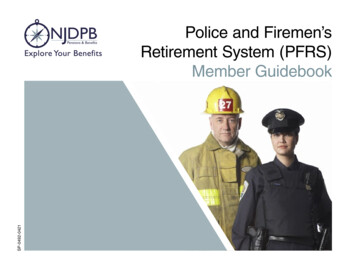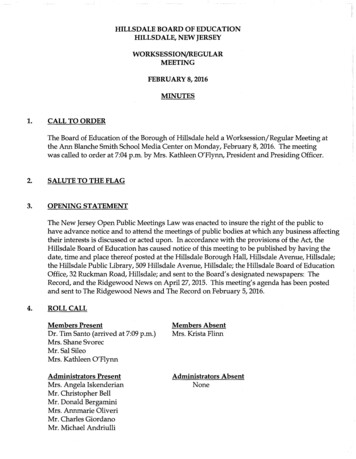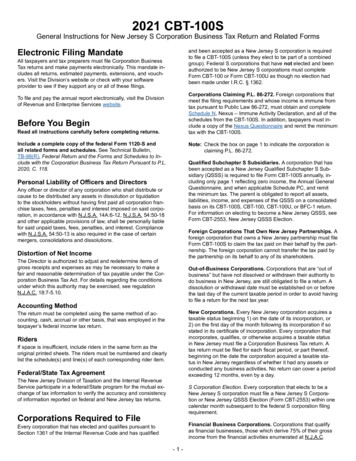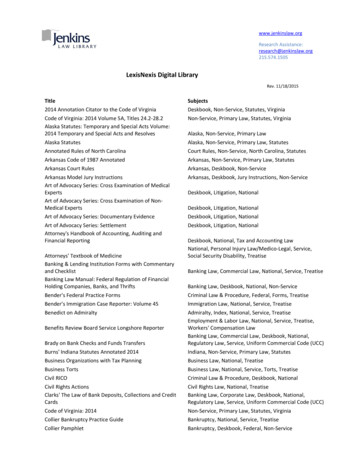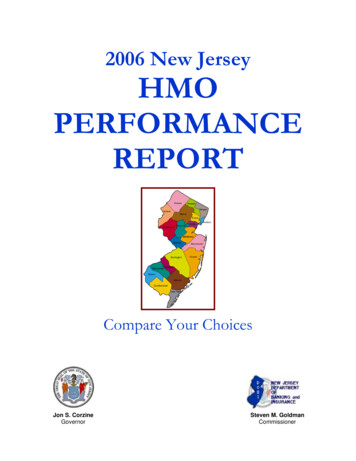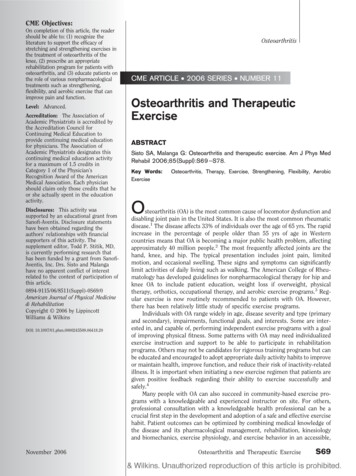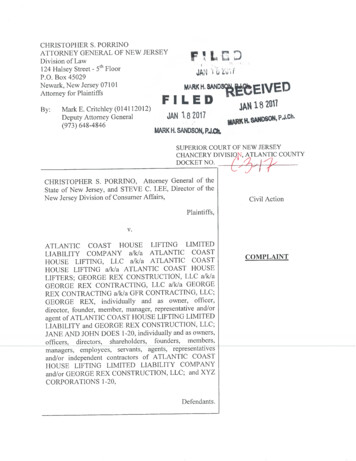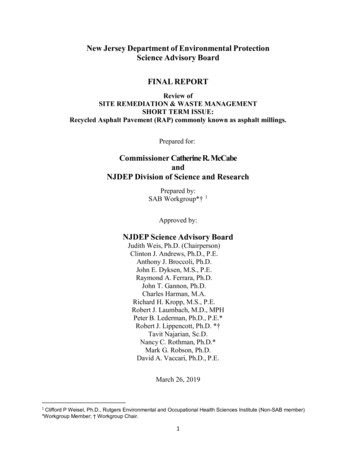
Transcription
New Jersey Department of Environmental ProtectionScience Advisory BoardFINAL REPORTReview ofSITE REMEDIATION & WASTE MANAGEMENTSHORT TERM ISSUE:Recycled Asphalt Pavement (RAP) commonly known as asphalt millings.Prepared for:Commissioner Catherine R. McCabeandNJDEP Division of Science and ResearchPrepared by:SAB Workgroup*†1Approved by:NJDEP Science Advisory BoardJudith Weis, Ph.D. (Chairperson)Clinton J. Andrews, Ph.D., P.E.Anthony J. Broccoli, Ph.D.John E. Dyksen, M.S., P.E.Raymond A. Ferrara, Ph.D.John T. Gannon, Ph.D.Charles Harman, M.A.Richard H. Kropp, M.S., P.E.Robert J. Laumbach, M.D., MPHPeter B. Lederman, Ph.D., P.E.*Robert J. Lippencott, Ph.D. *†Tavit Najarian, Sc.D.Nancy C. Rothman, Ph.D.*Mark G. Robson, Ph.D.David A. Vaccari, Ph.D., P.E.March 26, 20191Clifford P Weisel, Ph.D., Rutgers Environmental and Occupational Health Sciences Institute (Non-SAB member)*Workgroup Member; † Workgroup Chair.1
NJDEP Science Advisory BoardReview ofSITE REMEDIATION & WASTE MANAGEMENTSHORT TERM ISSUE:Recycled Asphalt Pavement (RAP) commonly known as asphalt millings.March 26, 2019NOTICEThis report has been written as part of the activities of the Department of EnvironmentalProtection’s (NJDEP’s) Science Advisory Board, a public advisory committee providingextramural scientific information and advice to the Commissioner and other officials of theNJDEP. The Board is structured to provide balanced, expert assessment of scientific mattersrelated to problems facing the Department. This report has not been reviewed for approval by theDepartment and, hence, the contents of this report do not necessarily represent the views andpolicies of the NJDEP, nor of other agencies in the Executive Branch of the State government, nordoes the mention of trade names or commercial products constitute a recommendation for use.Reports of the NJDEP’s Science Advisory Board are posted on the NJDEP Web site at:https://www.nj.gov/dep/sab/.2
SITE REMEDIATION & WASTE MANAGEMENTSHORT TERM ISSUE:Recycled Asphalt Pavement (RAP) commonly known as asphalt millings.NJDEP Charge Questions and Issue StatementHow can potential human health and environmental exposures to asphalt millings be minimizedin order to better utilize/recycle this material? What causes exposure? Does reuse of RAP causeleachate? How much RAP can be used with new asphalt? Why are we using residential-type'standards' for use of this product?Background: RAP is generated in large quantities in the State due to repaving of roads and demolitionactivities. Due to the presence of PAHs, a known carcinogen, recycling of RAP has manyrestrictions. Hot-mix Asphalt used for surface paving contains the same PAHs but its use does not haverestrictions as it is a product. Recycling options are very limited, which has generated illegal piles of RAP all over theState, especially at the Quarries with adjacent asphalt manufacturing Plant.INFORMATION NEEDED:a. What possible restrictions should there be for its reuse in New Jersey?b. Need scientific data based on research and studies to determine exposure pathways andpotential adverse impact of milled asphalt on human health and the environment.c. Need recommended reuses of RAP.d. Need BMPs for RAP Management.3
SITE REMEDIATION & WASTE MANAGEMENTSHORT TERM ISSUE:Recycled Asphalt Pavement (RAP) commonly known as asphalt millings.SAB ResponseIntroductionThe SAB has prepared this response to the above short term issue regarding RAP in accordancewith the related charge questions and stated information needs as noted above. Discussion andbackground information has been included where necessary to provide context and to clarifysome of the questions.Based on the background information provided above, it seems evident that an increased rate ofRAP reuse is desirable if such reuse can be accomplished in a manner that is protective of humanhealth and safety and the environment. The primary reuse of RAP is in road construction whereRAP is incorporated into the new roadway bituminous concrete admix. However, this reuseoption alone is unsustainable since only approximately 20% to 30% of the RAP generated fromtypical road and pavement projects is consumed back into pavement construction (Williams etal., 2018).Some of the current restrictions on storage, management or reuse of RAP are imposed due to thepresence of contaminants of concern (COCs) that are principally composed of polycyclicaromatic hydrocarbons (PAHs) and to a lesser extent, various metals. The PAHs in RAP derivemostly from the asphalt content in the RAP that is added as the (petroleum based) binder in thepavement manufacturing process, although some small amount may be from vehicle exhaust andfuel (Mehta, et al., 2017). RAP, like new asphalt pavement, contains approximately 3% to 7%asphalt with the remainder primarily being quarry materials that compose the load bearingportion of the original bituminous concrete material (FHWA, 2016). However, weathering ofasphalt pavement RAP causes hardening of the asphalt (FHWA, 2016) and loss of lowermolecular weight PAHs over time. The metals present in RAP due to exposure of roadway pavedsurfaces to vehicular use such as tire and break wear, metals in petroleum, as well as naturallyoccurring metals found in the quarried geologic materials (Mehta, et al., 2017). Otherrestrictions on RAP reuse appear to be due to engineering performance concerns for roadwayconstruction and load-bearing concerns under structures. For example, RAP is prohibited for usein subbase for certain roadway projects under the current (2007) NJDOT specifications.4
New Jersey Regulatory FrameworkThe management and reuse of RAP from road construction and demolition projects is regulatedprimarily by the New Jersey’s Solid Waste and Recycling Regulations (NJAC 7:26 and 26A) andguidance, including the NJDEP Division of Solid and Hazardous Waste’s (DSHW’s) March2013 Recycled Asphalt Pavement And Asphalt Millings (Rap) Reuse Guidance (DSHW RAPGuidance). According to this guidance, it is the policy of the NJDEP to encourage and promotethe use of recycled asphalt pavement (RAP), including asphalt millings excavated from publichighways and roads. RAP may be recycled without the Department’s prior approval, pursuant toexisting regulations at N.J.A.C. 7:26A-1.4(a)1, for recycling directly into hot mix asphaltpavement and in cases where it is reused directly for road construction when used in“Transportation Allowed Uses” in accordance with applicable NJDOT 2007 StandardSpecification for Road and Bridge Construction. The NJDOT regulations identify RAP as“reclaimed asphalt pavement” and provide specifications and limits for the amount of RAP thatmay be incorporated in pavement products used for certain paving applications (NJDOT 2007Standard Specifications for Road and Bridge Construction per N.J.A.C.16:44A). The NJDEPSite Remediation Program (SRP) also imposes additional requirements and restrictions on theuse of RAP for fill at remediation sites through guidance documents, including the NJDEPSRP’s April 2015 Fill Material Guidance for SRP Sites (SRP Fill Guidance). However, RAP isapparently not specifically defined in any of New Jersey’s regulations, and the definitions andrequirements for RAP in these guidance documents is somewhat inconsistent. A robustdiscussion of the technical basis and background in support of the current specific requirementsand policies is not included in the regulations or guidance, and is not readily available.However, a recent report of a RAP study conducted in 2017 by Rowan University (inconjunction with Columbia University and Stoney Brook University) for the NJDOT (Mehta, etal., 2017) provides some detailed technical background and a summary of research related toRAP, along with a report of laboratory studies of RAP from three locations in New Jerseyconducted by the authors. The report appears to serve as the technical basis for a New Jerseylaw approved in January 2018 that provides for expanded options for reuse of RAP (N.J.S.A.13:1E-99.28a; see Attachment 1). However, the regulations and guidance noted above have notbeen updated to reflect the new law at this time.As a preliminary matter, the definition of RAP is clarified for the purpose of this review.Although, the issue statement implies RAP is equal to asphalt millings, RAP is understood toinclude more than only asphalt millings. Although not defined in New Jersey’s regulations, RAPis defined in the DSHW RAP Guidance as follows:Recycled Asphalt Pavement (RAP): Recycled asphalt pavement (RAP) shall meanasphalt millings (the material produced from the milling of roads before repaving) andpieces of asphaltic roadway pavement removed from the roadway surface or subbase, orfrom other asphalt-paved surfaces such as parking lots. RAP does not include other ClassB recyclable materials that contain recycled asphalt.The above definition of RAP is adopted by the SAB for the purpose of this review and representsthe SAB’s intended definition in the following discussion and responses to the charge questions.5
While the above definition suffices for this review, some fundamental concepts should be noted.First, as RAP is derived from asphalt pavement, a basic understanding of the pavementmanufacturing and construction process is important for understanding the general nature ofRAP and how/why the composition may vary. In general, asphalt pavement is manufactured bymixing aggregate (e.g., sand and gravel, dense graded aggregate [DGA]) with a petroleum-basedbinder (asphalt). This is commonly performed in a heated process resulting in a “hot mix”pavement product. Other types of pavement products manufactured with less heat or unheatedinclude “warm mix” and “cold mix”, respectively. The aggregate is typically produced fromprocessing of quarried rock to specified grading and size specifications. Pavement is constructedin an upward sequence that generally includes a subbase gravel layer beneath a base course ofasphalt pavement covered by a top or wearing course, which is the upper-most exposedpavement surface. The top course typically includes coarse to medium sand sized aggregate,while base courses and subbase layers are usually constructed with larger size aggregate (e.g., ¾inch, 1-inch, etc.). Additional information, specifications and references related to asphaltpavement manufacturing and construction can be found in the United States Department ofTransportation (USDOT) Federal Highway Administration’s (FHWA’s) User Guidelines forWaste and Byproduct Materials in Pavement Construction (Pub. No. FHWA-RD-97-148, lastupdated 03/08/2016; a.k.a. “FHWA, 2016”).Second, the reference to “asphalt millings” in the above definition generally refers to the removalof the top wearing course pavement layer. Often, this process is performed using specializedequipment that can recycle asphalt millings on the paving project site within the pavingequipment. However, the admix designs for pavement projects and amounts of RAP reuse vary.Regardless, excess RAP is typically generated as a result of paving projects.Third, the form of RAP is another overarching issue not completely covered by the definitionabove. RAP may be comprised of asphalt millings only, or as “pre-processed” or ‘postprocessed” demolished asphalt pavement. Processing of RAP commonly includes crushing andsizing of RAP using screens that sieve crushed RAP to meet desired gradations – typically ¾inch or less. Processed RAP can also be “bound” (i.e., by combining with additional asphaltbinder) or “unbound” (i.e., no additional asphalt binder). Unprocessed RAP is generallyconsidered “unbound”, and can include large slabs, and cobble-sized pieces of demolishedpavement.Fourth, RAP comprised primarily of asphalt millings is expected to exhibit a higher internalsurface area and perhaps a high potential to mobilize by leaching or movement of particulates instorm water or by movement of particulates, for example, via erosion due to the high amounts ofsmaller particle sizes. In contrast, unprocessed RAP from sources other than milling ofpavement generally contains a range of sizing that would likely exhibit lower surface area andless percentage of fine particles as compared to asphalt millings. The general description ofgrain size and surface area for processed RAP derived from demolished pavement would fallsomewhere between that of milled asphalt and unprocessed RAP. This is based on a generalassumption that crushing and sizing of pavement results in larger sized granular RAP due to6
granular subbase and base courses that include larger size aggregate as compared to top coursemillings.Responses to Specific QuestionsThe order of the charge questions provided in the Issue Statement were reorganized and in somecases questions were revised for clarification and to more efficiently address the issues, and arerestated with responses below.What causes exposure?PAHs are the predominant COC present in RAP due to the asphalt binder used in pavementmanufacturing. RAP may also contain other COCs such as lead and other heavy metals, whichare generally associated with RAP as a result of vehicular use (fuel exhaust, tire and break wear,and natural occurring metals in the quarry stone) (Meta, 2017). Studies conducted to assessleaching of COCs from RAP have focused primarily on PAHs and to a lesser degree on metals(e.g., arsenic, lead, chromium, etc.). The specific metals of concern vary among the studies andthe presence and concentrations of metals are generally variable among studies (Townsend,1998; Winter, 2006; Meta, 2017). The variability in the presence of individual metals and theirrespective concentrations is likely related to sources of RAP and of the aggregate that was usedin the manufacturing of the original pavement from which the RAP derives. In limitedcircumstances, RAP can also potentially contain other COCs; for example, RAP sourced frompaved areas where process chemicals or waste may have been stored or handled. Butcontamination of RAP with COCs other than PAHs and metals from conditions specific to aparticular facility or area at a facility would be due to localized and somewhat limited conditionsthat are beyond the scope of this review. We will assume for this review that most of the RAPbeing managed in the overall circulation of material in New Jersey is from common roadway andparking area sources. For the purposes of this review, PAHs and metals are the principal COCsassociated with RAP from these types of common pavement areas (i.e., roadway areas,driveways, parking lots, etc.) that are understood to represent the bulk of the volume of RAP inNew Jersey.Based on the chemical fate and transport properties of PAHs and the form of metals generallyassociated with RAP (i.e., relatively extremely low water solubility; high organic carbonpartition coefficient [Koc] for PAHs), the potential leachability of PAHs and metals from asphaltpavement and RAP under a typical range of common environmental conditions is relatively low.The routes of exposure to the COCs typically present in asphalt pavement are limited in properlyinstalled and maintained paved surfaces due to the binding properties of the bituminouspavement manufacturing and installation process. However, RAP can break down tounconsolidated, soil-like particles similar in sizes to gravel, sand, silt, etc. The process of asphaltpavement demolition and weathering results in RAP containing large chunks to fine particles.However, weathering and use have similar aging effects on virgin asphalt pavement.7
Milling of asphalt road surfaces creates a RAP graded from a medium sand to dust-sizedparticles that can be subject to erosion by wind and water when exposed to the surface outdoorconditions. Asphalt pavement that is removed during demolition activities tend to break apartcreating a larger range of sizes of RAP from thick slabs to fine particles similar to asphaltmillings. However, the large-sized RAP can continue to break apart and weather with time andif disturbed, representing increased amount of fine-sized particles over time. While there may besome potential for leaching of COCs from RAP into adjacent soils and/or migration of dissolvedCOCs from RAP to ground water, the potential physical migration of fine particles from RAPcontaining COCs appears to represent additional exposure pathways. The general lack of PAHsand metals as COCs in ground water throughout New Jersey is indicative of the relative lowleaching potential of these substances from properly installed asphalt pavement (R.Lippencottpersonal experience from numerous NJDEP SRP investigations). Therefore, it is no coincidencethat the NJDEP allows the use of asphalt pavement as a capping contaminated material (e.g.,soil, historic fill material, alternative fill including RAP, etc.) as an option for remediation atcontaminated sites (SRP Fill Guidance).Migration pathways and exposure routes for COCs in RAP are practically limited to thoseassociated with COCs bound to particulates (e.g., dust in air and related inhalation, incidentalingestion, particulates in runoff and sediment deposition) and COCs that may leach and becomedissolved in water. However, the potential for exposure via aqueous environments (i.e.,groundwater and surface water) from leaching of COCs from RAP is considered very low due tothe low solubility of the COCs in RAP and the likelihood that the more leachable COCs willhave already leached out of most RAP material due to weathering.The incorporation of RAP with virgin asphalt or as subbase under pavement for creating newpavement, roadways, and parking lots or as a base for pavement that are properly sealed is notlikely to result in particulate COC exposure beyond what virgin asphalt pavement would, as thelatter weathers and potentially produces particles that can become mobilized.There is also a potential market for unbound RAP use for non-residential driveways, parkingareas, storage yards, temporary roads, or possibly residential driveways and parks. Thesemethods of unbound RAP reuse can lead to some exposure to RAP-related COCs if the materialbecomes worn, although exposure to RAP-related COCs would be lessened where RAP issubject to less mechanical stress from no or low vehicular traffic under some of these exposurescenarios. RAP use as a substitute for gravel on unpaved roads (e.g., for dust suppression)presents a potential source of airborne particulate matter containing COC from RAP that canpotentially lead to inhalation exposure and potentially incidental ingestion. For example,particulate matter from RAP could get onto the hands of particular children playing outside orafter being tracked into a home near locations where RAP material is located exposed at thesurface resulting in potential for incidental ingestion. While these conceptual scenarios areplausible for use of RAP in certain circumstances (e.g., residential areas), based on this review,there appears to be a lack of evaluation through scientific studies and/or research. In addition,these exposure scenarios are not necessarily different from similar exposures from commonpavement used in roadways and driveways, especially those that are old and worn.8
In general, binding or surface sealing of the RAP should be considered for some of these reusescenarios, for example residential or parks used often by children for playing. Unbound RAPused on roads would potentially be subject to additional mechanical abrasion and increasedpotential for airborne mobilization as wind-blown dust with increased vehicular traffic. Underthese conditions, the RAP particle size would likely decrease with time, leading to increasingamounts of RAP available to become airborne and increasing the potential for incidentalingestion. Thus, use of RAP on unpaved roads should be limited to rural roads with limitedtraffic and away from population centers and schools. If used on temporary unpaved roads forconstruction or commercial sites the locations should be sufficiently away from residentialsettings to not impact the air quality in surrounding areas.The concerns for contamination of drinking water supplies from the use of RAP is premised onthe leaching of COC into rainwater, surface or ground water that subsequently flows into anaquifer or reservoir leading to elevated levels in drinking water and ingestion exposure. This ismore likely related to metals contamination of RAP than PAH due to the low solubility of thelatter chemicals in water. Leaching is more likely to occur when the RAP is not sealed orcompletely mixed with virgin asphalt, such as when added as fill or to replace gravel in unpavedroads since a much greater surface area of the RAP material would contact the water. Theseconsiderations should be incorporated for temporary roadways (such as for construction sites) aswell as permanent roads, though in estimating the potential exposure it should be recognized thatdilution of leachate contaminants will occur prior to the water reaching an aquifer.It is not clear that the uncertainties regarding COCs and their relative concentrations in RAP arefully or adequately addressed in some of the references reviewed by the SAB. Mehta et al. (2017)notes differences in RAP samples obtained from various locations and suggests sampling of RAPto inform site-specific decisions under some conditions (e.g., pH 4). However, a more robustconceptual discussion of RAP sources and ranges of the inherent PAH concentrations expectedin RAP should be explored to facilitate developing technically based options for site-specificconditions. For example, RAP derived from some pavement demolition projects may becharacterized as containing very low concentrations of PAHs and no metals. In this case, asurface reuse option based on compliance averaging (e.g., spatially-weighted averaging in upper2-feet) may be protective and considered comparable to soils or pavement.Why are we using residential-type 'standards' for use of this product?As a clarification, residential standards are not applied to RAP in a consistent manner acrossstate programs. For example, the NJDEP SRP Guidance requires a deed notice for certain uses ofRAP in paving projects at remediation sites. However, the NJDOT allows essentially the samereuse of RAP in bound and unbound forms for pavement projects without requiring a deednotice. (A deed notice is an institutional control used by the NJDEP SRP to identify anddocument the presence of COCs above soil remediation standards at remediation sites.) TheSAB understands the reference to “residential-type standards” to mean the NJDEP’s residentialdirect contact soil remediation standards (RDCSRS; see New Jersey Administrative Code [NJAC9
7:26D]). While the RDCSRS are “soil” standards, they are ostensibly applied to non-soilmaterials like RAP, due to the similarity of soil and RAP regarding the routes of exposure.Although it is not soil, RAP can break down to become soil-like with respect to exposuremechanisms, as described elsewhere in this document. The NRDCSRS are established based onevaluation of three primary routes of exposure – inhalation, ingestion and dermal absorption. Interms of the exposure mechanisms assumed for calculation of the RDCSRS, there is essentiallyno difference between soil and RAP containing similar COCs (e.g., PAHs and metals).Potential exposure routes via aqueous pathways are addressed below since they are notnecessarily limited to residential scenarios.It should be noted that the reference to RAP as “product” in the charge question was notconsidered by the SAB in this response, since the term has no bearing on a technical/scientificevaluation of RAP, or on any technically feasible management options that can are proven to beprotective of human health and safety, and the environment.Does reuse of RAP result in leaching of COCs?The original question (Does reuse of RAP cause leachate?) was restated for clarification becausethe term “leachate” can have more than one meaning and carry with it connotations of darkviscous liquid typically associated with landfills.Also, the answer to this questions is conditional based on the type of RAP reuse beingconsidered. For example, there is practically no concern about leaching of COCs when RAP isproperly recycled in asphalt pavement and road/pavement construction. While there is somelimited potential for leaching when unbound RAP is used or stored with surface exposure or inunprotected piles. Thus, the focus of this discussion is on the latter scenarios (i.e., RAPreuse/storage other than reuse in pavement construction).Studies conducted in Minnesota and Denmark (see ref. in Mehta et al., 2017) evaluated leachatefrom RAP and conclude RAP generally does not cause leachate. However, the studies appearsimilar to other studies that evaluate potential for leaching of COCs from RAP, and do notnecessarily address potential for to contribute to landfill leachate.The potential for reuse of RAP to result in leaching of COCs depends on several factors relatedto the type of reuse and site conditions where reuse is to take place. However, based on theresearch reviewed, and fate and transport characteristics of the RAP and related COCs, thepotential for RAP to leach PAHs and metals is relatively low.The charge question asks about leachate but it does not necessarily raise the issue of particulatesand suspended solids that may harbor undissolved concentrations of COCs. The term “leachate”includes substances that may be dissolved in water that comes into contact with RAP, but doesnot include suspended solids. While migration of particulates and suspended solids are not acommon concern in ground water, their migration to surface water bodies may be a legitimateconcern under some circumstances (e.g., direct contact with surface water, potential for10
significant mass transfer of RAP to sediment bed via erosion and discrete conveyance, etc.).However, the use of dissolved COC concentrations reported in published leachate studies forgeneralized evaluation of impacts the surface water is not advisable for several reasons;primarily because the test methods for evaluation of leachate are designed for assessment ofdissolved substances not migration of particulates. Also, surface water quality criteria areintended for in-stream, ambient surface water quality assessment. Thus, a simple directcomparison of test leachate concentrations without consideration of other assimilative factors islikely to result in impact estimates that are erroneously conservative and unnecessarilyrestrictive.To provide context, comparisons between new asphalt pavement or pavement surface sealcoatings and RAP may be informative. Surface seal coating of RAP with asphalt or tar binders iscurrently recommended (i.e., effectively required) in the SRP RAP Guidance for certain uses.However, some studies indicate that PAH concentrations in runoff from coated surfaces arehigher than non-coated pavement surfaces. This is likely related to the higher concentrations ofPAHs in seal coat products as compared to asphalt pavement (Williams, et al. 2018). Otherstudies have reported a decrease of COC concentrations in leachate extracts over relatively shorttime frames (Townsend, 1998). This is ostensibly due to several factors including early loss ofmore soluble PAH compounds that are present at higher concentrations in fresh asphaltpavement as asphalt products weather or cure. This is especially important when consideringRAP since RAP is generally composed of older asphalt that has been subject to extensiveweathering prior to reuse. Thus, the potential for PAH leaching from RAP may be lower thanfor new asphalt pavement or asphalt surface seal coatings, while surface seal coatings mayprovide some decrease in particulates migration. Although, Processing of RAP (milling orcrushing) will tend to increase surface area and increase the percentage of finer particle sizes,which could counter effects of weathering and represent a potential for an increase in leaching ofCOCs. Differences in pre-processed vs. post-processed RAP is also a consideration that mayimpact potential leaching or particulates migration.How can potential human health and environmental exposures to asphalt millings beminimized in order to better utilize/recycle this material?Theoretically, casual exposure to RAP is not a major concern due to the relatively lowleachability of the COCs and relatively low exposure. In many respects RAP is comparable toasphalt pavement, especially with so many crumbling streets and paved areas that appearubiquitous especially in urban areas. Also consider the square miles of paved roadways andother surfaces in NJ vs. the relatively small areas of RAP.Hypothetically, development of generalized scenarios that may conceptually model conditionsthat are similar to those at actual known sites may be helpful to evaluate and establish guidelines.However, extreme, unrealistic hypothetical scenarios should be avoided for use to establishgeneral guidelines.11
Practically, it seems the growing RAP piles are mostly at the quarries and asphalt pavementmanufacturing plants. Although, RAP is sometimes used as a cheap gravel, DGA, or as apavement alternative for construction of surfaces. Use in quarry reclamation, especially whereasphalt pavement is produced and where RAP is already handled seems to be a reasonable optionto consider for reuse of RAP under certain site conditions. Quarry reclamation often requiresextremely large amounts of fill. Use of RAP in quarry reclamation may be feasible where itcould be considered protective of human health (e.g., direct contact exposures such as inhalationand incidental ingestion) and provided protection of water resources can be demonstrated, e.g.,via geological and hydrogeological conditions, monitoring of ground water at sentinelcompliance points, storm water runoff controls, etc.How much RAP can be us
Standard Specifications for Road and Bridge Construction per N.J.A.C.16:44A). The NJDEP Site Remediation Program (SRP) also imposes additional requirements and restrictions on the use of RAP for fill at remediation sites through guidance documents, including the NJDEP SRP's April 2015 Fill Material Guidance for SRP Sites (SRP Fill Guidance).
